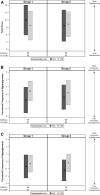Improved Glycemia with Hybrid Closed-Loop Versus Continuous Subcutaneous Insulin Infusion Therapy: Results from a Randomized Controlled Trial
- PMID: 36472543
- PMCID: PMC10081723
- DOI: 10.1089/dia.2022.0421
Improved Glycemia with Hybrid Closed-Loop Versus Continuous Subcutaneous Insulin Infusion Therapy: Results from a Randomized Controlled Trial
Abstract
Objective: To evaluate safety and effectiveness of MiniMed™ 670G hybrid closed loop (HCL) in comparison with continuous subcutaneous insulin infusion (CSII) therapy for 6 months in persons with type 1 diabetes (T1D). Methods: Adults (aged 18-80 years), adolescents, and children (aged 2-17 years) with T1D who were using CSII therapy were enrolled and randomized (1:1) to 6 months of HCL intervention (n = 151, mean age of 39.9 ± 19.8 years) or CSII without continuous glucose monitoring (n = 151, 35.7 ± 18.4 years). Primary effectiveness endpoints included change in A1C for Group 1 (baseline A1C >8.0%), from baseline to the end of study, and difference in the end of study percentage of time spent below 70 mg/dL (%TBR <70 mg/dL) for Group 2 (baseline A1C ≤8.0%), to show superiority of HCL intervention versus control. Secondary effectiveness endpoints were change in A1C and %TBR <70 mg/dL for Group 2 and Group 1, respectively, to show noninferiority of HCL intervention versus control. Primary safety endpoints were rates of severe hypoglycemia and diabetic ketoacidosis (DKA). Results: Change in A1C and difference in %TBR <70 mg/dL for the overall group were significantly improved, in favor of HCL intervention. In addition, a significant mean (95% confidence interval) change in A1C was observed for both Group 1 (-0.8% [-1.1% to -0.4%], P < 0.0001) and Group 2 (-0.3% [-0.5% to -0.1%], P < 0.0001), in favor of HCL intervention. The same was observed for difference in %TBR <70 mg/dL for Group 1 (-2.2% [-3.6% to -0.9%]) and Group 2 (-4.9% [-6.3% to -3.6%]) (P < 0.0001 for both). There was one DKA event during run-in and six severe hypoglycemic events: two during run-in and four during study (HCL: n = 0 and CSII: n = 4 [6.08 per 100 patient-years]). Conclusions: This RCT demonstrates that the MiniMed 670G HCL safely and significantly improved A1C and %TBR <70 mg/dL compared with CSII control in persons with T1D, irrespective of baseline A1C level.
Keywords: A1C; Adult; Diabetes treatment satisfaction; Hybrid closed loop; Pediatric; Time below range; Time in range; Type 1 diabetes.
Conflict of interest statement
All principal investigator authors received research support from Medtronic to conduct the clinical trial at their respective investigational site. A.K., C.L., B.M., T.L.C., J.S., S.W.L., A.S.R., and R.A.V. are or were employees of Medtronic.
Figures



References
-
- Diabetes Control and Complications Trial Research Group, Nathan DM, Genuth S, et al. : The effect of intensive treatment of diabetes on the development and progression of long-term complications in insulin-dependent diabetes mellitus. N Engl J Med 1993;329:977–986. - PubMed
-
- White NH, Cleary PA, Dahms W, et al. : Beneficial effects of intensive therapy of diabetes during adolescence: outcomes after the conclusion of the Diabetes Control and Complications Trial (DCCT). J Pediatr 2001;139:804–812. - PubMed
-
- Diabetes Control and Complications Trial (DCCT)/Epidemiology of Diabetes Interventions and Complications (EDIC) Study Research Group: Mortality in type 1 diabetes in the DCCT/EDIC versus the general population. Diabetes Care 2016;39:1378–1383. - PubMed
Publication types
MeSH terms
Substances
Grants and funding
LinkOut - more resources
Full Text Sources
Medical

